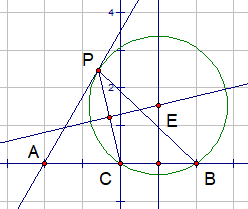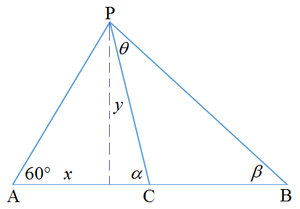Slide that angle!
A B = 4 , C is the midpoint of A B .
P is a point that satisfies ∠ P A B = 6 0 ∘ , but we don't know where it is.
When ∠ B P C is maximized, what is the length of A P ?
The answer is 2.82843.
This section requires Javascript.
You are seeing this because something didn't load right. We suggest you, (a) try
refreshing the page, (b) enabling javascript if it is disabled on your browser and,
finally, (c)
loading the
non-javascript version of this page
. We're sorry about the hassle.
4 solutions
Wow, and I thought I was being clever with my solution. This is great.
A note on notation: I hope I'm not being pedantic, but C H is a segment, not a distance. The distance from C to H should be written as either C H or ∣ C H ∣ .
Log in to reply
Oh, I didn't know that. I thought C H also stands for the distance.
Thanks for telling me about this (because I don't really want to type the "\overline{...}" for every distances, haha!).
How about a solution with no trigonometry? ∠ B P C is maximized when the circumcircle of △ B P C is smallest. So we just need to find the perpendicular bisectors of P C and C B .
Place C = ( 0 , 0 ) , A = ( − 2 , 0 ) , B = ( 2 , 0 ) , and P on the line y = 3 ( x − 2 )

The perpendicular bisectors intersect at E , we need to minimize the y-coordinate of this point.
The perpendicular bisector of C B is x = 1
The other will take more work but is ultimately y = 3 ( 3 a + 6 a x + 6 a + 1 2 a 2 + 2 a + 2 )
The y-coordinate of the intersection is 3 ( 3 a + 6 2 a 2 + 5 a + 6 )
We can minimize with a calculus derivative to find a = 2 − 2
This is the x-coordinate of P . The horizontal distance to A is 2
Finally A P = 2 2
I editted to the length of A P .
I also posted a solution to this problem(the start is really similar to yours), and it shows that the 6 0 ∘ is not nessesarily needed.
By law of cosines on △ C A P , C P 2 = A P 2 + 2 2 − 2 ⋅ A P ⋅ 2 ⋅ cos 6 0 ° , or C P 2 = A P 2 − 2 A P + 4 .
By law of cosines on △ B A P , B P 2 = A P 2 + 4 2 − 2 ⋅ A P ⋅ 4 ⋅ cos 6 0 ° , or B P 2 = A P 2 − 4 A P + 1 6 .
By law of cosines on △ B P C , 2 2 = C P 2 + B P 2 − 2 ⋅ C P ⋅ B P ⋅ cos ∠ B P C . Substituting the above C P and B P equations and rearranging, we have cos ∠ B P C = ( A P 2 − 2 A P + 4 ) ( A P 2 − 4 A P + 1 6 ) A P 2 − 3 A P + 8 .
Using derivatives we find that ∠ B P C is maximized when A P = 2 2 ≈ 2 . 8 2 8 4 3 .
Hi David, Shouldn't the numerator be (AP²-3AP+10). Besides, how did you maximize <BPC?
Log in to reply
I believe my numerator is correct. The constant term is 2 4 + 1 6 − 2 2 = 8 .
Letting θ = ∠ B P C and x = A P , I squared both sides and used implicit differentiation:
cos 2 θ = ( x 2 − 2 x + 4 ) ( x 2 − 4 x + 1 6 ) ( x 2 − 3 x + 8 ) 2
cos 2 θ = x 4 − 6 x 3 + 2 8 x 2 − 4 8 x + 6 4 x 4 − 6 x 3 + 2 5 x 2 − 4 8 x + 6 4
− 2 cos θ sin θ ⋅ d x d θ = ( x 4 − 6 x 3 + 2 8 x 2 − 4 8 x + 6 4 ) 2 x 5 − 3 x 4 + 2 4 x 2 − 6 4 x
− 2 cos θ sin θ ⋅ 0 = ( x 4 − 6 x 3 + 2 8 x 2 − 4 8 x + 6 4 ) 2 x 5 − 3 x 4 + 2 4 x 2 − 6 4 x
0 = x 5 − 3 x 4 + 2 4 x 2 − 6 4 x
0 = x ( x 2 − 8 ) ( x 2 − 3 x + 8 )
which has only one positive real solution x = 2 2 .

Let A be the origin ( 0 , 0 ) , then B ( 4 , 0 ) and C ( 2 , 0 ) . Let P ( x , y ) , ∠ B P C = θ , ∠ P C A = α , and ∠ P B A = β . We note that ∠ B P C = θ is larger when tan θ is larger for 0 ∘ ≤ θ < 9 0 ∘ and that
tan θ = tan ( α − β ) = 1 + tan α tan β tan α − tan β = 1 + ( 2 − x ) ( 4 − x ) y 2 2 − x y − 4 − x y = x 2 − 6 x + 8 + y 2 2 y = 2 x 2 − 3 x + 4 3 x = 2 x − 3 + x 4 3 Note that y = 3 x
Note that tan θ is maximum when 2 x + x 4 is minimum. By AM-GM inequality , we have 2 x + x 4 ≥ 2 2 x ⋅ x 4 = 4 2 . Equality occurs when 2 x = x 4 or x = 2 .
Then A P = cos 6 0 ∘ x = 2 2 ≈ 2 . 8 2 8 .
If we draw the circumcircle of △ B P C (centered at O ), then 2 ∠ B P C = ∠ B O C .
If the circumradius( R ) gets smaller, then ∠ B O C will be bigger. So, we want the circumcircle to be tangent to A P .
Let O H ⊥ B C . So, C H = 1 .
O A 2 = A H 2 + O H 2 = O A 2 + O C 2 − C H 2 = 9 + R 2 − 1 = 8 + R 2
A P 2 = O A 2 − O P 2 = 8 + R 2 − R 2 = 8 , A P = 2 2
Notice that we doesn't really need ∠ P A B = 6 0 ∘